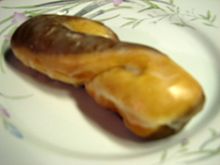
A doughnut or donut is a type of food made from leavened fried dough. It is popular in many countries and is prepared in various forms as a sweet snack that can be homemade or purchased in bakeries, supermarkets, food stalls, and franchised specialty vendors. Doughnut is the traditional spelling, while donut is the simplified version; the terms are used interchangeably.

A zeppola is an Italian pastry consisting of a deep-fried dough ball of varying size but typically about 4 inches (10 cm) in diameter. This fritter is usually topped with powdered sugar, and may be filled with custard, jelly, cannoli-style pastry cream, or a butter-and-honey mixture. The consistency ranges from light and puffy, to bread- or pasta-like. It is eaten to celebrate Saint Joseph's Day, which is a Catholic feast day.
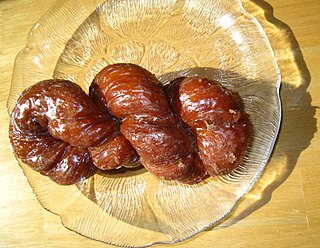
A cruller is a deep-fried pastry like a doughnut popular in Europe and North America often made from a rectangle of dough with a cut made in the middle that allows it to be pulled over and through itself, producing twists in the sides of the pastry. The cruller has been described as resembling "a small, braided torpedo". Some other cruller styles are made of a denser dough somewhat like that of a cake doughnut formed in a small loaf or stick shape, but not always twisted. Crullers may be topped with powdered sugar or icing.
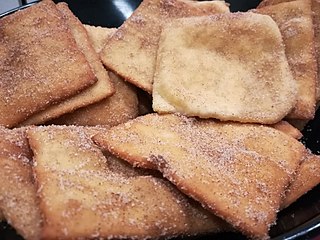
A sopaipilla, sopapilla, sopaipa, or cachanga is a kind of fried pastry and a type of quick bread served in several regions with Spanish heritage in the Americas. The word sopaipilla is the diminutive of sopaipa, a word that entered Spanish from the Mozarabic language of Al-Andalus. The original Mozarabic word Xopaipa was used to mean bread soaked in oil. The word is derived in turn from the Germanic word suppa, which meant bread soaked in liquid.

Mister Donut is an international chain of doughnut stores. It was founded in the United States in 1956 by Harry Winokur. Primary offerings include doughnuts, coffee, muffins and pastries. After being acquired by Allied Domecq in 1990, most of the North American stores became Dunkin' Donuts. Outside of the United States, Mister Donut maintains a presence in Japan, El Salvador, Philippines, Thailand, Taiwan, and Nigeria.

A buñuelo is a fried dough fritter found in Spain, Latin America, and other regions with a historical connection to Spaniards, including Southwest Europe, the Balkans, Anatolia, and other parts of Asia and North Africa. Buñuelos are traditionally prepared at Christmas. It will usually have a filling or a topping. In Mexican cuisine, it is often served with a syrup made with piloncillo.

Spudnut Shops were American franchised stores selling donuts made with potato flour called Spudnuts. The parent company no longer exists, but independent stores remain. The original recipe is based on a folk recipe that traces back to Germany.

BeaverTails is a Canadian restaurant chain, specializing in pastries known as BeaverTails, that is operated by BeaverTails Canada Inc. Its namesake products are fried dough pastries, individually hand stretched to resemble beaver's tails, with various toppings added on the pastry.
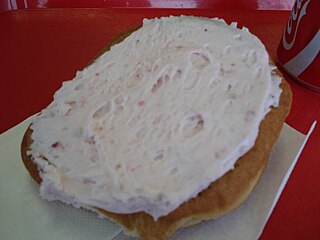
A Persian, Persian roll or Pershing is a fried sweet roll or doughnut with a spiral shape similar to a cinnamon bun. It may be covered with a sugar glaze, iced or frosted, or sprinkled with sugar or cinnamon sugar.
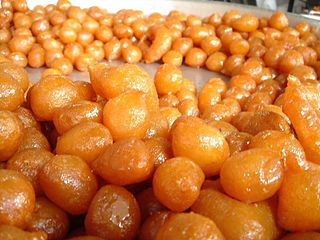
Lokma is a dessert made of leavened and deep fried dough balls, soaked in syrup or honey, sometimes coated with cinnamon or other ingredients. The dish was described as early as the 13th century by al-Baghdadi as luqmat al-qādi, "judge's morsels".
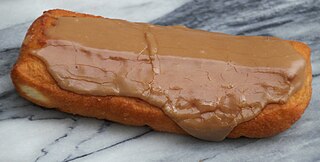
The Long John is a bar-shaped, yeast risen pastry like a doughnut either coated entirely with glaze or top-coated with cake icing. They may be filled with custard or creme. The term Long John is used in the Midwestern U.S. and Canada, and has been used in Texas.

The coconut doughnut is a variety of doughnut in the United States and Canada that is usually covered or topped with shredded or flaked coconut topping. It is often toasted or broiled, and there are variations made with chocolate and, in a 1959 recipe, orange juice in the dough and icing.

The old-fashioned doughnut is a term used for a variety of cake doughnut prepared in the shape of a ring with a cracked surface and tapered edges around it. Nineteenth century recipes for "old-fashioned donuts" are made with yeast, but in modern doughnut shops an "old-fashioned doughnut" is usually a cake doughnut. Cake doughnuts made with chemical leavener originated in the United States circa 1829. Primary ingredients in the old-fashioned doughnut include flour, sugar, butter, eggs, sour cream or buttermilk, and chemical leavener. It is typically deep fried, may have a crunchier or crisper texture compared to other styles of cake doughnuts, and typically has cracks and pores on its surface. After being fried, it is glazed, dusted with sugar, or served plain.

A wonut, doffle, wownut, waffle-donut or waffle nut is a hybrid food made from a combination of the cooking techniques and ingredients of a waffle and a doughnut. A mixture of the waffle batter and the doughnut dough are first poured into a waffle iron, then deep fried and finally decorated, with toppings similar to doughnuts. The wonut became popular in the spring of 2014 at the Waffles Cafe in the Lake View community area of Chicago, and its popularity quickly spread via bloggers and social media. It can now be found throughout the United States and beyond.
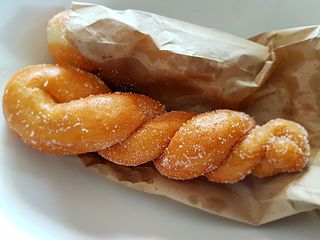
Twisted doughnuts are yeast donuts or sticks of pastry made from wheat flour or glutinous rice flour, deep-fried in oil. In China, they are known as mahua (麻花); in Korea, they are known as kkwabaegi (꽈배기) in the Philippines, they are known as shakoy and pilipit, in Japan, they are known as sakubei.

Mochi donuts, also known as poi mochi, are a fusion pastry crossing traditional American doughnuts and Japanese mochi. The mochi donuts' "hybrid batter makes for a doughnut that is fluffy and moist, with a satisfying chew". An early iteration can be traced to Hawaii in the early 1990s, however, the mochi donut was popularized by Mister Donut's "Pon de Ring" iteration in the early 2000s. Mochi donuts are now most commonly shaped into eight small balls connected into a circular shape that is easy to pull apart and are made out of glutinous rice flour or tapioca flour.
